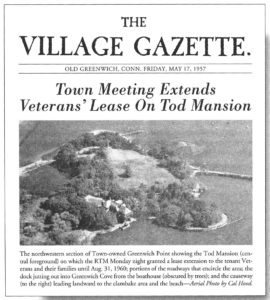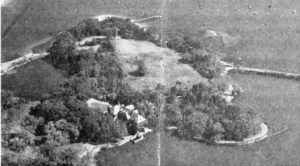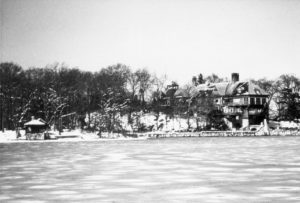
By Mary A. Jacobson, Oral History Project editor
Thousands of people enjoy the beauty and sanctuary of Tod’s Point, yet few are aware of its connection to the veterans of WWII. From 1946 to 1961, the former mansion of Mr. and Mrs. J. Kennedy Tod, the original owners of Tod’s Point (known now as Greenwich Point), served as a residence for WWII veterans and their families. The home was demolished in 1961.
In 1981, the Oral History Project published, “Tod’s Point, An Oral History,” a complete history of Tod’s Point from its earliest times populated by Indians. Sixty-seven narrators were interviewed for this extensive project, and it is from this rich trove that the stories of the WWII veterans are excerpted.
from its earliest times populated by Indians. Sixty-seven narrators were interviewed for this extensive project, and it is from this rich trove that the stories of the WWII veterans are excerpted.
In 1945, the Town of Greenwich purchased the 148-acre property of Tod’s Point from Columbia-Presbyterian Hospital, to whom it had been bequeathed upon Tod’s death, for the sum of $550,000. The mansion on the property had not been used as a residence since Mrs. Tod died in 1939. Concurrently, with the end of WWII, veterans were returning home to a severe housing shortage. Approval was given by the Town of Greenwich to lease the mansion to 13 veteran families for one dollar a year.
 The 13 families planned to move into the mansion in 1946. First, however, its 39 rooms had to be converted into 13 apartments. They formed an independent nonprofit corporation called Vetaptco (Veterans’ Apartment Corporation). Each family floated a $1,000 loan from a local bank (The Greenwich Trust Company). According to resident Nicholas Thiel Ficker, “We paid (monthly) rent to our own corporation. I think 40 dollars was the cheapest and 70 dollars was the most expensive. Of that, 29 dollars went to the bank. The balance went into our Vetaptco account, and from that we paid for our oil, our heat, our electric, and so forth.”
The 13 families planned to move into the mansion in 1946. First, however, its 39 rooms had to be converted into 13 apartments. They formed an independent nonprofit corporation called Vetaptco (Veterans’ Apartment Corporation). Each family floated a $1,000 loan from a local bank (The Greenwich Trust Company). According to resident Nicholas Thiel Ficker, “We paid (monthly) rent to our own corporation. I think 40 dollars was the cheapest and 70 dollars was the most expensive. Of that, 29 dollars went to the bank. The balance went into our Vetaptco account, and from that we paid for our oil, our heat, our electric, and so forth.”
To ready the apartments, according to Ficker, “This contractor (Peter Danziger) did the basic work and we did all the finishing work. We did all the painting, and some of the plastering, and a lot of the carpentry.” Ficker continued, “To get 13 young families living down there, it took some courage…It’s cut off from the public, you know, during the dark and winter months…For that particular time, we were all young, just out of the army. It was fun.”
was fun.”
Living at Tod’s Point had its challenges. The Town plowed the snow only to the entrance to Tod’s Point. During a blizzard at Christmastime in 1947 Ficker recalled, “Well, we didn’t have any snow shovels. So, we took these sheets of aluminum and cut them up and made long wooden handles and nailed these rectangular pieces of aluminum to the wooden handles and made about thirteen shovels. We shoveled all day long, and at six o’clock at night, we finally broke through to Shore Road where they had plowed it.”
Another emergency, that required a communal response, was the inadequate septic system. As Ficker described, “The septic system filled up…There was an old, poor old septic tank, and it just couldn’t take it any longer. On Thanksgiving Day of 1946, we dug a whole dry field. Thirteen men got out there with shovels, picks, and we dug trenches through that. We honeycombed that whole field, laid tiles, filled in gravel, and connected it in with the septic tank which was across the road…We worked up an appetite for turkey.”
 Resident Martha Hankins credits her childhood years living at “the Point” with her lifelong appreciation of the environment. “Just the experience of everything and being able to just have so much around you, so much nature, and nature still really affects me…And the bird sanctuary, around Thanksgiving time all the ducks would flock into the lake. There’d be thousands of ducks in the lake.” Ficker reminisces “…we’d go down to the pond. We had a big net on the end of a long pole, and we’d catch blue crabs. Oh boy! Blue crabs were all over the place.”
Resident Martha Hankins credits her childhood years living at “the Point” with her lifelong appreciation of the environment. “Just the experience of everything and being able to just have so much around you, so much nature, and nature still really affects me…And the bird sanctuary, around Thanksgiving time all the ducks would flock into the lake. There’d be thousands of ducks in the lake.” Ficker reminisces “…we’d go down to the pond. We had a big net on the end of a long pole, and we’d catch blue crabs. Oh boy! Blue crabs were all over the place.”
By 1961, the last family moved out. According to Ficker,” I think it ended simply because time had run out on it…The Town had said they wouldn’t renew the lease, and there was good reason…It was really starting to get run down. It would have taken a tremendous amount of money to put it into any shape at all…And then there was the decision to demolish the house. Of course, we were all sad to see it go.” Unfortunately, before it was torn down, the building was vandalized. “It was a mess.”
Martha Hankins returned to her apartment shortly before the demolishment. “The piano we had was pushed down the stairs…I couldn’t come back to see it torn down. It was just too much for me, because we had good memories there.” Resident Joseph Callachan agreed, “It was just a simply marvelous experience, and one that we’re awfully glad we have in our background.”
down the stairs…I couldn’t come back to see it torn down. It was just too much for me, because we had good memories there.” Resident Joseph Callachan agreed, “It was just a simply marvelous experience, and one that we’re awfully glad we have in our background.”
The book, “Tod’s Point, An Oral History,” may be read in its entirety at Greenwich Library and is available for purchase at the Oral History Project office. The OHP is sponsored by Friends of Greenwich Library. Visit the website at glohistory.org. Mary A. Jacobson, OHP blog editor.




